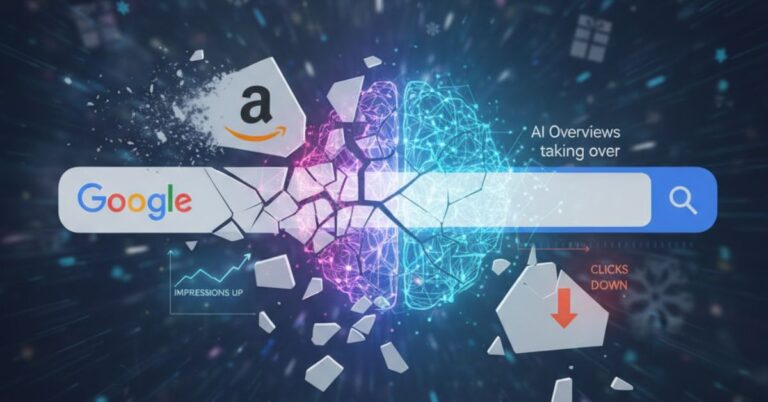
Amazon's complete disappearance from organic product grids highlights a massive Google search visibility shift, forcing brands to adapt to a new era of AI-powered search.
Google is the go-to place for 49% of shoppers discovering new products, yet Amazon’s presence in Google’s organic search has dramatically dropped this year.
This Google Search Visibility Shift means the familiar landscape of holiday shopping is shifting fast.
With Amazon out of the picture, AI Overviews and new search features are taking the spotlight, leaving sellers scrambling to adapt their strategies amid this upheaval.
Data Shows Staggering Drop in Amazon's Search Visibility
Carbon 6"Off-Amazon search channels have proven particularly powerful, driving 41% of total sales and an impressive 58.6% cart-to-purchase conversion rate."
A dramatic shift in Google’s search results has seen e-commerce giant Amazon experience a near-total loss of organic product visibility. As reported by Roger Montti on Search Engine Journal, new data from the marketing platform Audience Key reveals the stunning decline.
The change follows two strategic moves by Amazon, though a direct causal link has not been confirmed. The company recently discontinued its paid Google Shopping ads and consolidated its three merchant names into the single “Amazon” identity.
Initially, these changes coincided with a 31% drop in Amazon’s presence in Google’s organic product cards. Its listings fell from over 428,000 appearances to just under 295,000 after July 25th.
The situation then escalated dramatically beginning on August 18th. Data shows Amazon was subsequently and completely removed from Google’s organic product grids, a move that reshapes the e-commerce search landscape.
The impact was not spread evenly across product categories, with some experiencing much steeper declines than others. The apparel category was hit hardest, with visibility being cut by more than half in several key segments.
Hardest-Hit Categories
- Apparel saw multiple segment drops between 56% and 60%.
- Home Goods’ visibility fell by 45%.
- Laptop Computers’ presence was reduced by 36%.
Other Affected Categories
- Outdoor Furnishings: Declined by 28%.
- Business Supplies: Dropped by 22%.
- Indoor Decor: Fell by 16%.
- Tires: Saw a 15% decline.
This massive shift leaves the industry questioning the cause. Speculation suggests this could be a strategic move by Amazon to withhold its product feed or the result of a significant technical change.
How Should Sellers Adapt to This Google Search Visibility Shift
Smart sellers and brand owners know they should not just rely on the chance that their Amazon listings will appear on Google. Instead, they are building ecommerce websites and implementing SEO practices as the foundation of their long-term visibility strategies.
In her Modern Retail article, Julia Waldow wrote that brands are now preparing for GEO, or generative engine optimization, which many leaders call the “future of SEO.” GEO refers to optimizing content so it surfaces in AI-driven platforms like ChatGPT, Google Gemini, or Perplexity – engines that increasingly drive shopping discovery.
Nearly 60% of U.S. consumers have used a generative AI tool for online shopping, according to an August 2025 Omnisend survey. This shift means brands want to appear in results when customers ask AI engines about products ranging from lip gloss to laptops.
Retail executives admitted the transition is not easy. For decades, brands refined SEO playbooks to climb rankings on Google, but GEO introduces an entirely new layer of optimization focused on conversational, context-driven queries.
Some companies have already begun reshaping their strategies:
- Target is prioritizing price, product, promotions, availability, and policies, making its site data “machine readable” for AI systems.
- Edible Brands is focusing on long-form Q&A content and structuring metadata so AI can easily process product information.
- Every Man Jack is experimenting with long-tail, community-driven conversations on Reddit and creating content specifically designed for AI LLMs to read.
- Credo Beauty is monitoring customer searches, such as “foundation for olive skin tones,” and updating content in cycles to reflect real consumer demand.
Notably, companies aren’t abandoning SEO. Traditional keyword search still drives 30–40% of traffic, but AI-driven search behavior is growing. Retailers report customers are using longer, more conversational queries even on standard retail websites, signaling that GEO practices will blend with SEO rather than replace it outright.
While many questions remain unanswered about what factors LLMs prioritize, one reality is clear: GEO is no longer a concept on the horizon. For brands looking to maintain visibility in search-driven shopping, it is the new reality they must adapt to now.
AI Overviews Reshape the Holiday Search Landscape
According to Nicole Silberstein from Retail TouchPoints, Google’s AI Overviews are creating a seismic change in how consumers shop online. Instead of clicking through pages of search results, users are getting direct answers, leading to sharp declines in organic traffic for publishers and retailers.
A Pew Research Center study revealed that users encountering an AI summary clicked through to traditional search results just 8% of the time, compared to 15% when no summary appeared. BrightEdge reported a 30% decline in average click-through rates since May 2024, when AI Overviews rolled out widely.
While traffic to individual websites is falling, impressions are rising. BrightEdge data shows impressions are up 49%, meaning brands are being seen more often, even if customers are not immediately visiting their sites.
Google reports that AI Overviews now serve more than 2 billion users monthly across 200+ countries. From Google’s perspective, this creates more opportunities for advertisers to appear in search results earlier in the decision-making process.
The company is urging marketers to adapt by:
- Understanding how AI search is shifting consumer shopping behaviors
- Focusing on consumer intent rather than narrow keywords
- Using AI-driven creative and demand-gen tools to scale faster
- Investing in multimedia storytelling to appear in AI-led conversations
For Amazon sellers, these changes underscore the value of partnering with an Amazon agency. Agencies help brands diversify beyond Amazon’s marketplace, ensuring visibility through SEO, paid ads, and off-Amazon content strategies designed for both traditional search and AI-powered discovery.
Consumer behavior is also evolving as AI becomes the norm. Impulse buying is down, deliberate research is up, and the holiday shopping season has stretched into a three-month marathon. Customers now weigh factors such as price, convenience, shipping, and policies all at once, with AI making the comparison process easier and faster.
For marketers, manual processes are no longer enough. Google is pushing its own AI-driven tools, including Performance Max, to help advertisers create ad variations, test quickly, and optimize for broader intent-driven searches.
Storytelling is also gaining traction as a differentiator. With AI engines scanning vast online sources, authentic product feedback and verified reviews are influencing search results more than ever. Brands that combine optimized content, creative campaigns, and structured data stand a better chance of showing up in both AI Overviews and traditional placements.
The bottom line: AI has rewritten the search playbook. Brands that embrace these changes – often with the guidance of an experienced Amazon agency – will be better positioned to capture demand in the most competitive shopping season of the year.
April Berthene, author at Chief Marketer"AI will define the 2025 holiday season."






